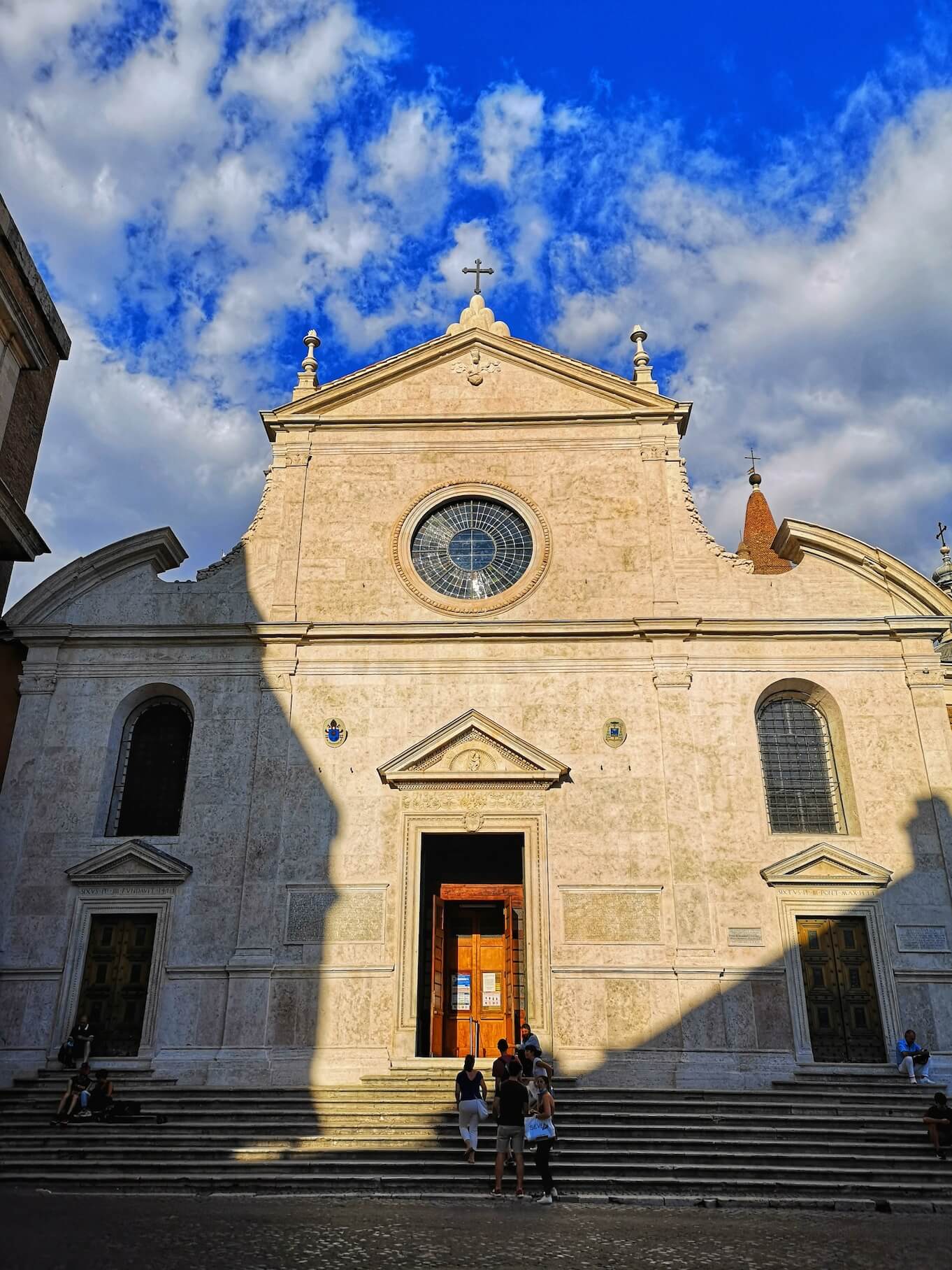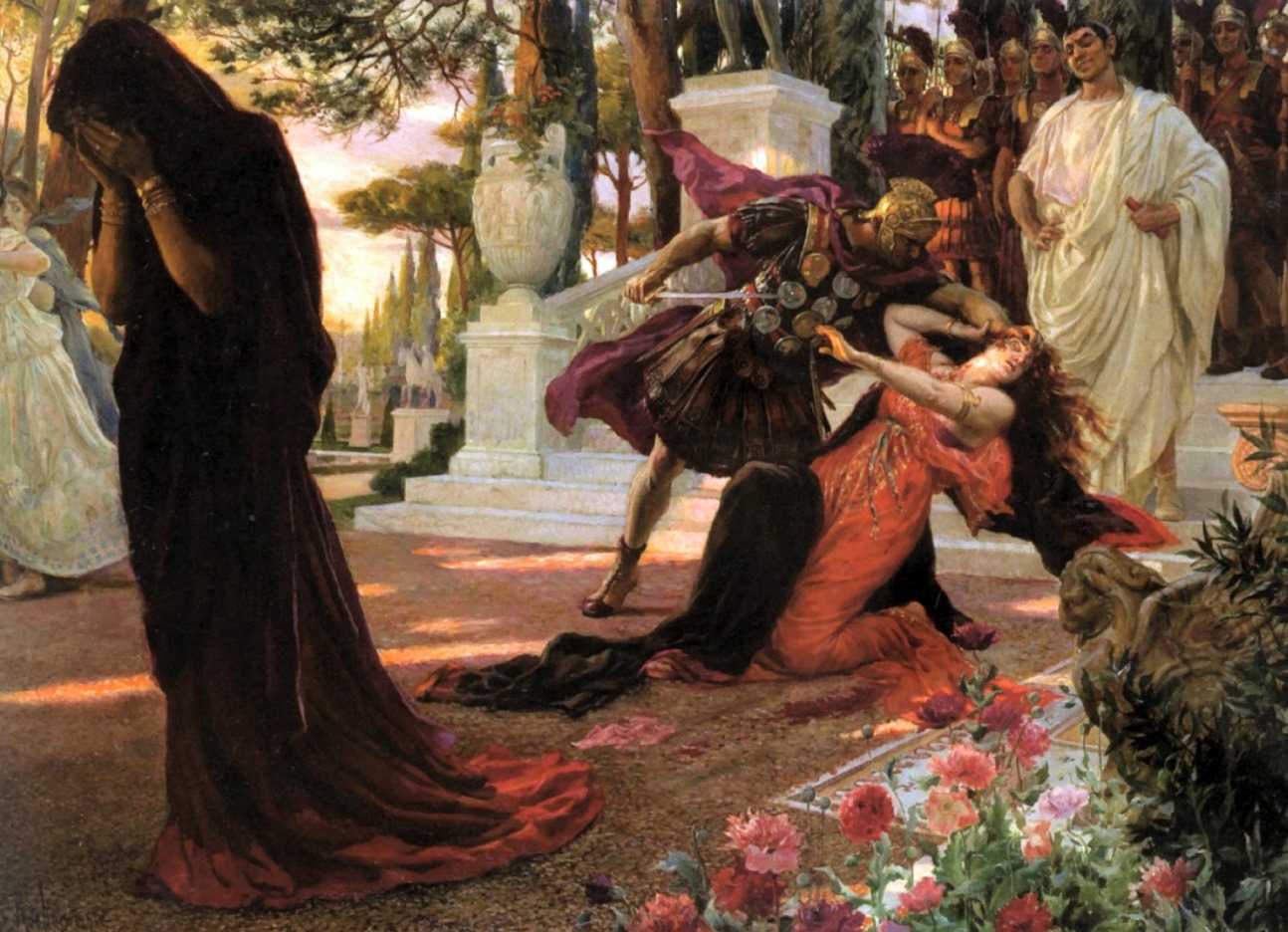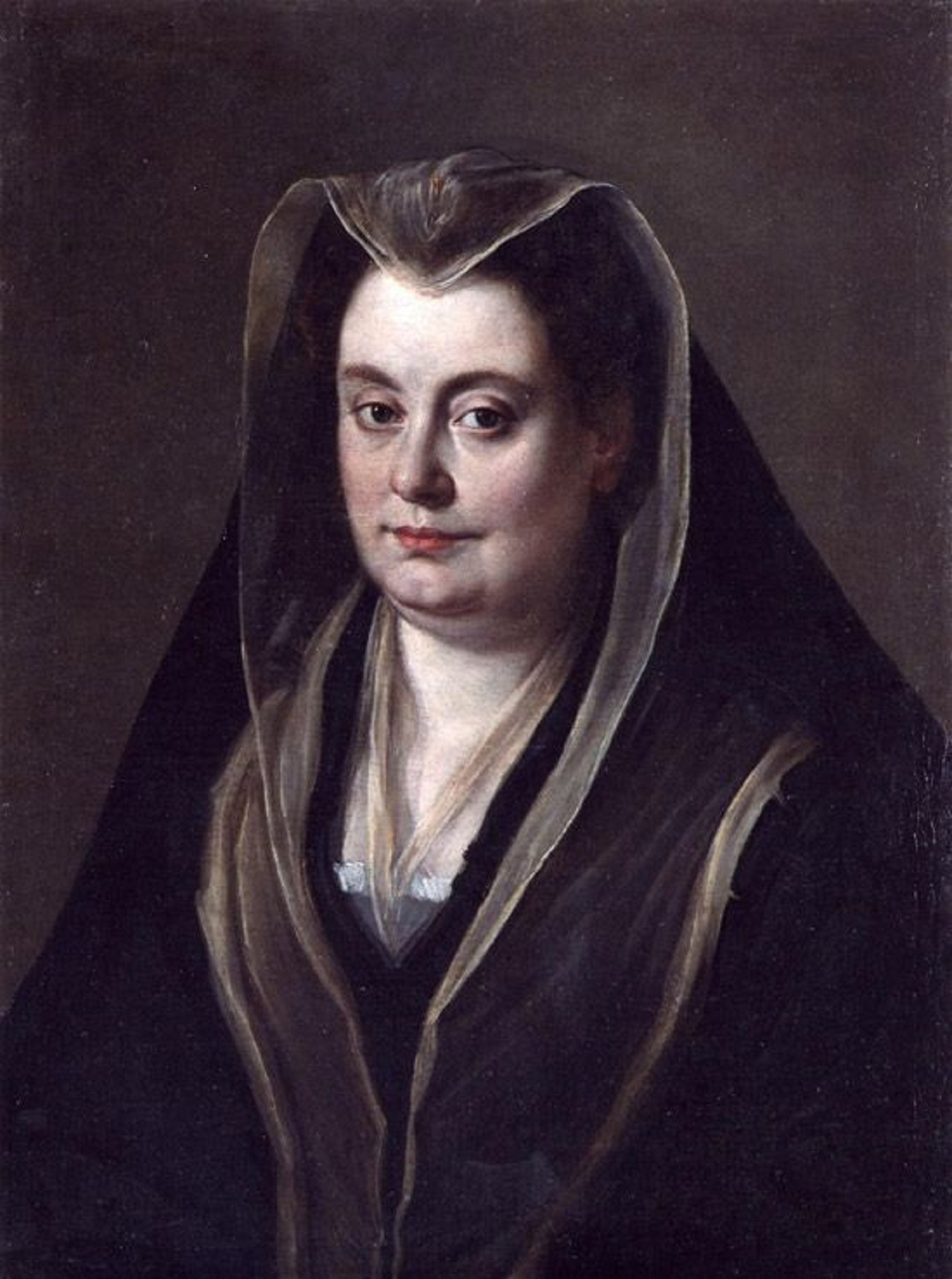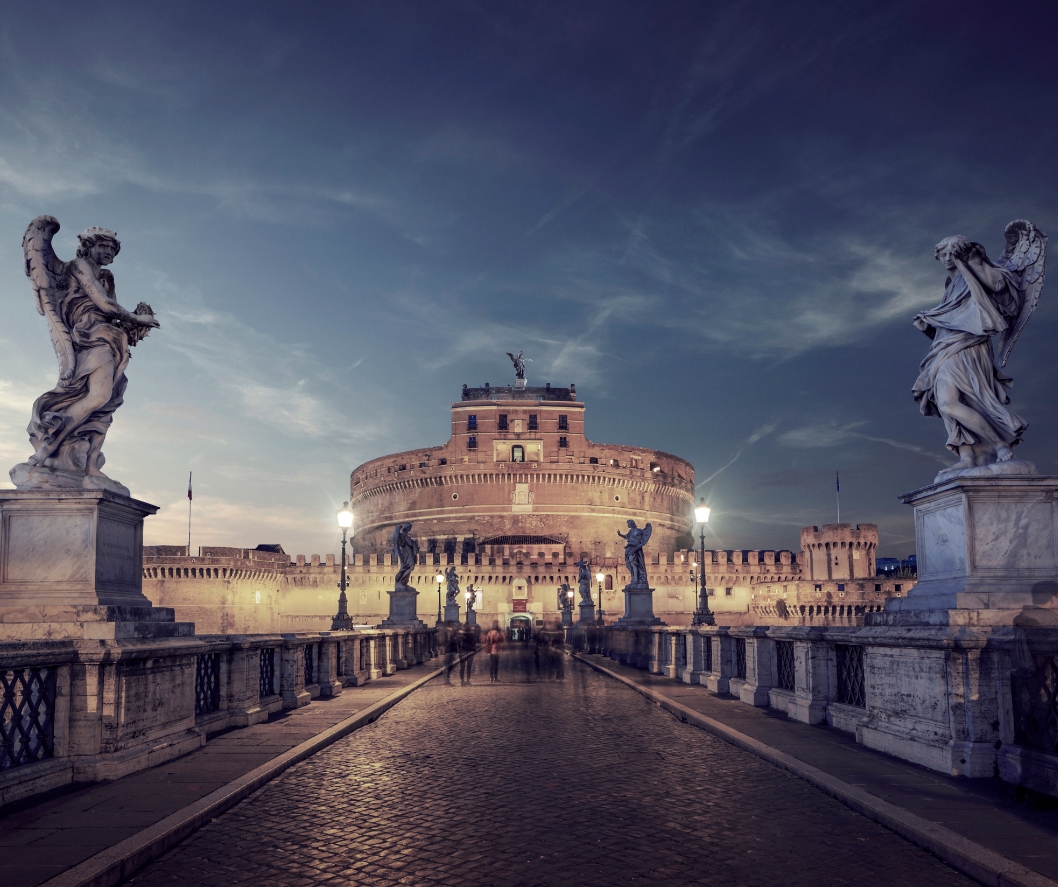While the foggy alleys of London or York may seem like more natural settings for a ghost story, Rome, a city with nearly 3,000 years of history, certainly has a few skeletons in its closet. The dark cobbled lanes and echoing piazzas of the Eternal City take on a different atmosphere once the sun has set and the trattorias have shuttered for the night. Rome, in the dead of night, can be quite spooky - indeed, you might feel like you're not entirely alone. Read on and come and meet some of Rome's oldest residents...
Naughty Nero's Restless Spirit at Piazza del Popolo

After Nero's suicide in AD 68, the senate expressed their loathing of the emperor with a decree of "Damnatio Memoriae," damning his memory and legacy. This decree meant that he couldn't be interred in the Mausoleum of Augustus, the traditional burial place of the Caesars. Instead, he was buried in a tomb on the Pincian Hill, which now overlooks Piazza del Popolo.
According to legend, the emperor's restless spirit began to haunt the area, taking the form of a murder of crows that used to roost in a walnut tree that had sprung from the ancient sepulcher. The Romans became terrified upon hearing the shrieks of tortured souls and claimed to see ghostly apparitions and demons lurking in the dark, feasting with witches among the thickets and woods on the slopes of the hill.
Eventually, in the 11th century, the locals threw themselves on the mercy of Pope Paschal II, begging him to rid them of Nero's spirit. The Pope came to locals' aid, visiting the Pincian Hill, where he discovered the walnut tree, the crows, and Nero's wretched tomb. He chopped the tree down, untangled the emperor's remains from the roots, and had Nero's bones and ashes cast into the Tiber River. Then, he had a chapel dedicated to the Virgin built on top of the haunted spot, today the Church of Santa Maria del Popolo.
For most, this seems to have dispelled Nero's ghost. However, some say his tortured spirit lingers on further up the hill - so watch out for crows if you're wandering the Pincian Hill at night.
The Empress Messalina - Nymphomaniac or a Scheming Political Libertine?

Messalina lived in the 1st century AD. She was the third wife of the aging emperor Claudius, a man 30 years her senior, and she was one of the most notorious women to have ever lived in ancient Rome.
Ancient writers describe her as a sexually insatiable schemer who embarrassed the emperor and scandalized Roman society with her escapades.
A serial adultress and nymphomanic, her exploits are the stuff of legend - including a twenty-four-hour sex competition with a prostitute - Messalina won with a score of 25. Indeed, they say she used to keep a room at the brothel and used to go by the alias "Lupa," the She-Wolf. The Romans had a different nickname for her: "Meretrix Augusta," the Whore Empress.
Messalina's antics came to an abrupt and brutal end when she pushed her husband too far. While Claudius was away in Ostia, she plotted to overthrow her husband by marrying a Roman senator, Gaius Silius, with the aim of putting him on the throne of Rome.
Her plan failed - Claudius had her lover executed, and Messalina, who, despite pleading for mercy, was given the option of an honorable Roman death - suicide. Alas, she was unable to muster the courage to end her own life, and one of the praetorian guards had to help her along to the next life.
Much of the gossip about Messalina is exaggerated, if not wholly untrue, but her reputation endures. Perhaps this is why her ghost is restless. She is said to be seen wandering the Coppian Hill near the Colosseum in the dead of night. Reports describe a beautiful woman in a white toga, her arms adorned with jewels and a diadem in her loose flowing hair, in search of yet another lover. Other legends tell of young men having their bottoms mysteriously pinched in Piazza Navona by the lusting empress.
Costanza Conti de Cupis - The Perfect Porcelain Hands in a Window
In the 17th century, a great beauty, Costanza Conti, lived in Rome. She was renowned not just for her grace and elegance but also for her exquisitely delicate hands. She was the envy of other noble women and had a string of men vying for her hand in marriage. She eventually married the nephew of Cardinal Giandomenico De Cupis and moved to the grand Palazzo Cupis on Via di Santa Maria dell'Anima, just beside Piazza Navona.
Even with marriage, her beauty did not diminish, with artists begging her to sit for a portrait. One such artist, Bastiano Alli Serpenti, was so enchanted by her perfect hands that he made a plaster cast of them to display in his studio for people to admire. One day, a stranger visited the studio, saw the cast, and foretold that the woman to whom these beautiful hands belonged would soon lose them.
Costanza came to learn of this dark omen and, horrified, demanded the cast be destroyed. She became a recluse, terrified to leave her palace for fear of the prophecy coming true. However, it seems her fate was sealed - one day, while embroidering, she pricked her finger with a needle. The pinprick soon became infected, and the doctors told her that the only way to save her arm was to have her beautiful hand amputated. She reluctantly agreed, but it seemed it was already too late - the infection had already spread, and poor Costanza died a few days later from septicemia.
Costanza's spirit may have passed on, but it seems her beautiful hands linger on. If you're passing Palazzo Cupis on the night of a full moon, look up. You might just see a beautiful ghostly hand in the window.
Beatrice Cenci - The Tragic Tale of a Muse Who Haunts a Bridge

One of the most tragic and haunting tales you'll hear in Rome is the story of Beatrice Cenci.
Beatrice lived in the 16th century, the daughter of Francesco Cenci, a powerful and ruthless nobleman with a reputation for violence and sadism.
Once Beatrice came of age, it became apparent that she was a great beauty. Her father found an excuse to whisk her and her stepmother away to the family castle outside of Rome, ostensibly for their protection. However, in reality, they were prisoners, and it was an open secret that Beatrice was regularly subject to violence and sexual abuse at the hands of her father.
The family pleaded for help, but their pleas fell on deaf ears. Francesco's power was too intimidating for anyone to intervene. Eventually, in desperation, Beatrice, her stepmother, and brothers plotted to murder Francesco. One night on the 8th of September, 1598, they drugged Francesco's wine, causing him to fall into a deep slumber. Then they beat the tyrant to death and threw his mangled corpse over the castle balustrade to make it look like he'd fallen to his death.
Alas, the authorities didn't believe the family's tale, and Beatrice, her brothers, stepmother, and other accomplices were arrested. Their trial lasted for over a year, and Beatrice never once admitted to the murder, even under torture. Her plight swayed the Roman public, who knew what a monster her father was and pleaded with the Pope for clemency. The Pope (ironically named Clement VIII) was a stickler for the rule of law and refused to offer mercy. His only act of leniency was to allow Beatrice's 12-year-old stepbrother to live. However, the rest of the family, Beatrice, her stepmother, and her brothers, were all sentenced to death.
The fateful day arrived on the 11th of September, 1599. Beatrice and her family were brought to the scaffold in front of Castel Sant'Angelo on the banks of the river. The crowd swelled, with people falling into the river and jostling for position. Beatrice's plight struck a chord with the Romans, who felt that a gross injustice was being done.
The Cenci family ascended the scaffold one by one to meet the executioner's block. Beatrice's young brother was forced to watch in horror as his family was beheaded in front of him. They say Beatrice retained her dignity until the end, even as they led her up the scaffold, eliciting the admiration of the crowd, appalled at the barbarity.
Beatrice has since inspired countless artists and writers - her story has been committed to paper by the likes of Stendhal, Shelly, and Dumas. The painter, Guido Reni, is said to have glimpsed the doomed beauty on the way to her death as she was carted through the city. He later captured her likeness in the iconic painting we have of her today.
And as for Beatrice? Well, they say she returns every year on the night of the 10th of September, the night before her death. She's said to be seen wandering along Ponte Sant'Angelo, dressed in white, cradling her head in her arms. Those who live in Palazzo Cenci today say they can hear her weeping and sometimes see her beautiful, melancholic ghost roaming the corridors.
Donna Olimpia - The Formidible "La Pimpaccia"

In the 17th century in Rome, Donna Olimpia Maidalchini lived in a lavish and sprawling palace in Piazza Navona. Better known as "La Pimpaccia," she was a woman of humble birth from Viterbo who rose to become one of Rome's most influential and notorious women.
As a teenager, she escaped a life destined for a convent by accusing the local prelate of molesting her to guarantee her escape. Soon after, she found herself a wealthy, frail, and elderly husband. When he died a few years later, she became a comfortable widow of means and decided to move to Rome.
Olimpia was incredibly clever and ambitious and was determined to raise her position in society, so she found another husband - this time from one of Rome's most influential and noble families, Pamphilio Pamphilj. Her new brother-in-law, a rising star in the Church, was soon to become Pope (Innocent X).
Politically astute, she soon became the Pope's most trusted confidante, and the nobility would woo her with gifts and favors to win her favor and gain access to the Pope. Her power and influence became infamous, with Romans leaving poems about her on the city's famous "talking statues." In these poems, she earned herself a few nicknames: "Papessa" (the female Pope) and "La Pimpaccia" (far more derogatory, roughly translating to a woman of sin). Her influence on the Pope grew even more after her husband's death, with rumors even suggesting she was the Pope's lover. Olimpia didn't care that she was reviled, though, because she was powerful and protected.
Her world came crashing down in 1655 when the Pope's health failed, and he died on the night of the 7th of January. Realizing she was no longer protected, Olimpia hastily packed what she could and fled the city. According to legend, she filled two crates with gold coins from under the Pope's bed, loaded them onto a carriage, and sped from Piazza Navona across the Ponte Sisto.
The Pope's successor, Alexander VII, demanded the return of the Papal gold in vain and banished Olimpia from Rome. She died from the plague just two years later.
Be careful if you wander down to the river Tiber in winter: Roman legend says that "la Pimpaccia" returns every year on the night of the 7th of January. You'll hear the sound of the horses' hooves clatter over the cobblestones and hear Pimpaccia cackle in the night before you see her black flaming carriage tear across Ponte Sisto into the night, where the mouth to Hell opens and swallows her up. Don't get too close, or she may take you with her!
Mastro Titta - The Man in the Red Cloak & the Pope's Executioner

Giovanni Battista Bugatti, better known as "Mastro Titta," was Rome's longest-serving executioner. He served the Papal States for 68 years and had over 500 executions to his name. Renowned for his meticulous attention to detail, he recorded all his endeavors in a personal notebook. The names, dates, crimes and the minuscule execution of his victims were recorded with painstaking detail.
Mastro Titta lived in Rome between 1779 and 1869. Due to his grim profession, he was not allowed to live within the city walls. So, he took up residence across the river, in the Borgo near the Vatican, where he sold umbrellas when not dispatching his victims.
Traditionally, executions in Rome happened in just a few spots. One of the most famed locations was in front of Castel Sant'Angelo. They were huge events that drew massive crowds and were performed with great pomp and ceremony. Quite the perennial showman, he always arrived in a long hooded red cloak. Apparently, he used to offer his victims a pinch of snuff before he put them to death and then would parade their severed heads around the scaffold for the horrified crowd to see.
Renowned writers such as Charles Dickens witnessed this grisly spectacle and described how Mastro Titta "retreated to his lair, (once) the show was over."
They say his favorite place to work was in front of Castel Sant'Angelo. So, be careful if you wander the bridge alone at night. If you encounter an elderly man dressed in red who wants to give you a snuff of tobacco, take pause; it might just be Mastro Titta in search of another victim to add to his list...
MORE GREAT CONTENT FROM THE BLOG:
- The Best Vatican Tours to Take in 2024
- Where to Find the Devil in Rome
- A Pilgrim and Tourists Guide to Jubilee 2025
- How to Climb the Dome of St. Peter's Basilica
- 7 Things You Need to See in St. Peter's Basilica
- Art and Faith in the Vatican: The History of St. Peter's Basilica
- Visiting St Peters and the Vatican Museums: A Practical Guide
- A Guide to the Vatican Gardens






